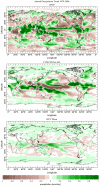Greenhouse warming and the 21st century hydroclimate of southwestern North America
- PMID: 21149692
- PMCID: PMC3003097
- DOI: 10.1073/pnas.0910856107
Greenhouse warming and the 21st century hydroclimate of southwestern North America
Abstract
Climate models robustly predict that the climate of southwestern North America, defined as the area from the western Great Plains to the Pacific Ocean and from the Oregon border to southern Mexico, will dry throughout the current century as a consequence of rising greenhouse gases. This regional drying is part of a general drying of the subtropics and poleward expansion of the subtropical dry zones. Through an analysis of 15 coupled climate models it is shown here that the drying is driven by a reduction of winter season precipitation associated with increased moisture divergence by the mean flow and reduced moisture convergence by transient eddies. Due to the presence of large amplitude decadal variations of presumed natural origin, observations to date cannot confirm that this transition to a drier climate is already underway, but it is anticipated that the anthropogenic drying will reach the amplitude of natural decadal variability by midcentury. In addition to this drop in total precipitation, warming is already causing a decline in mountain snow mass and an advance in the timing of spring snow melt disrupting the natural water storage systems that are part of the region's water supply system. Uncertainties in how radiative forcing will impact the tropical Pacific climate system create uncertainties in the amplitude of drying in southwest North America with a La Niña-like response creating a worst case scenario of greater drying.
Conflict of interest statement
The authors declare no conflict of interest.
Figures



 , Top Right), the mean flow advection term (
, Top Right), the mean flow advection term ( , Bottom Right), and the transient eddy convergence (
, Bottom Right), and the transient eddy convergence ( , Bottom Left). All units are mm/day.
, Bottom Left). All units are mm/day.

References
-
- Milly PCD, Dunne KA, Vecchia AV. Global pattern of trends in streamflow and water availability in a changing climate. Nature. 2005;438:347–350. - PubMed
-
- Seager R, et al. Model projections of an imminent transition to a more arid climate in southwestern North America. Science. 2007;316:1181–1184. - PubMed
-
- Mote P, Hamlet AF, Clark MP, Lettenmaier DP. Declining mountain snowpack in western North America. B Am Meteorol Soc. 2005;86:39–49.
-
- Mote P. Climate-driven variability and trends in mountain snowpack in western North America. J Climate. 2006;19:6209–6220.
Publication types
MeSH terms
LinkOut - more resources
Full Text Sources

